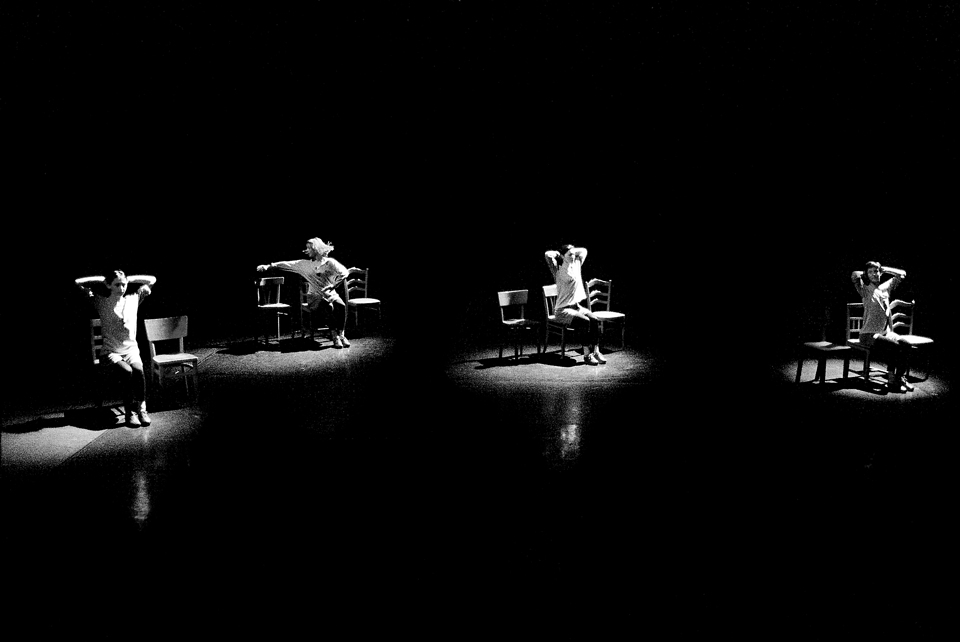#ReRosas
Camille LeFevre weighs in on the recent return of the dance company, Rosas, to the Twin Cities to perform the mid-80s work that made Anne Teresa De Keersmaeker famous.

1983 was a quite a year for dance. Trisha Brown premiered her pioneering, loose-limbed dance style with the now-iconic work, Set and Reset. The Brooklyn Academy of Music (BAM) launched its Next Wave Festival to showcase new cross-disciplinary collaborations by young artists. Flashdance hit the silver screen and set young women everywhere to tossing their hair and cutting free the necklines of their t-shirts. Men Without Hats cavorted to The Safety Dance in their Ren-Fest inspired MTV video. George Balanchine died.
And across the pond, Belgian choreographer Anne Teresa De Keersmaeker founded her dance company, Rosas. In 1991, the Walker Art Center—in collaboration with the Ordway Music Theatre and The Suitcase Fund of Dance Theater Workshop—brought Stella to the Ordway’s then-McKnight Theatre, giving Twin Cities audiences our first taste of De Keersmaeker’s work.
But it was only last week that the Walker and Northrop presented Rosas danst Rosas, the work that premiered in 1983 and positioned De Keersmaeker as a founding member of the Belgian new wave that forever changed the dance world. The piece has lost none of its power, beauty, ferocity and mesmerizing deliberation over the years.
Comprised of four sections and performed by four women, Rosas danst Rosas utilizes repeating phrases of movement that are nearly always performed in unison, whether with relentless military precision, loose luscious deliberation or riveting exhausting power. (De Keersmaeker is wonderfully transparent about the making of the work and its construction: details are available on the company’s website.)
Within the formalism, there are moments of repose, quicksilver flashes of movement and trancelike toppling that ends in curves against the floor, arms switching from fists to scythes. Performed to a minimalist industrial score by Thierry De Mey and Peter Vermeersch—except for long portions in which there is no sound at all, but for the dancers’ audible breath, as synchronized as their movements—the work is a rigorous exploration of choreographic patterning and rhythm.
A particular view of femininity permeates the piece, marked by rigorous mythmaking still relevant—even 30-some years later—to a 21st-century audience. While each of the four women imbues her performance with an individual sensibility, there’s undeniable power within the unison: complicity in the head nods, enjoyment in the smiles, sensuality in phrasing, daring in both the baring and covering of shoulders, flirtation in the hands they run through their hair, and selflessness within the synchronicity.
Now 54, De Keersmaeker joined three other dancers last Wednesday in the opening night performance, the work’s Midwest premiere. Where some might have suspected the choreographer of marking in places, others saw an exceptional economy and efficiency of movement, denoting not only De Keersmaeker’s instinctual familiarity with the choreography she created but also a maturity that eschewed the necessity of enthusiasm—as gorgeous as that was on the younger dancers.
Similarly, much has been made of Rosas danst Rosas popular influence, from Beyonce’s snitching of the work’s staging, phrasing and hands-through-hair gestures for her hyperkinetic “Countdown” video to the Re:Rosas project, in which participants can learn the choreography or interpret it, film themselves and post to social media with #ReRosas.
The kineticism of the infectious, repetitive phrasing seeps into the mind, muscles and nerves like a meme, begging for manifestation in the bodies of whomever it encounters. Which is why nothing matches the experience of seeing the work performed live by Rosas. It also explains why the work’s kineticism spans time in the concert dance world, from the beauty of Lucinda Child’s minimalist repetition to the mesmerizing eroticism of Sarah Michelson’s post-modern phrasing.
Camille LeFevre is a long-time dance writer in the Twin Cities and the editor of The Line, an online publication about the creative economy of the Twin Cities.